In the kitchen, we’ve all faced the great egg white dilemma. What’s better: stiff peaks or soft peaks?
Egg whites, a simple ingredient, hold a secret to the fluffiest desserts. We all want that perfect texture in our recipes.
I once turned my meringue into what I affectionately call a “kitchen disaster.” It was supposed to be light and airy. Learned my lesson.
Soft peaks gently fold over like a wave, offering a tender incorporation into batters. Stiff peaks, on the other hand, stand tall and proud. They’re the backbone of meringues that don’t droop.
We’ve got the scoop on how each affects your favorite sweets. No more kitchen disasters, we promise.
Achieving that perfect peak can feel like a rite of passage.

What are Stiff Peaks?
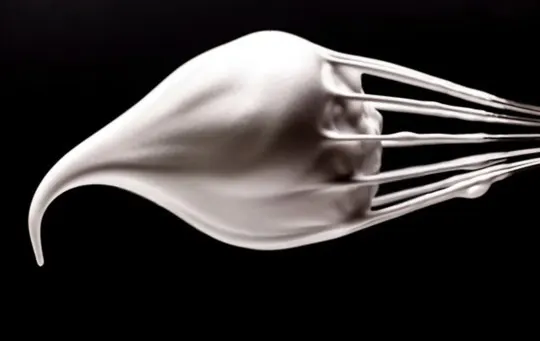
When whipping cream, you may have come across the term “stiff peaks.
” Stiff peaks refer to a stage when whipped cream can hold its shape and form sharp peaks when scooped with a spoon.
This process requires a mixer to incorporate air into the cream, giving it volume and stability.
Stiff peaks are important in recipes that require whipped cream to hold its shape, such as in frosting or mousse.
It also adds texture and body to desserts and can be used for decorating cakes and pastries.
It’s important not to over-whip the cream, as it can turn into butter.
To prevent this, pay close attention to the texture of your whipped cream as you go along.
Once stiff peaks form, stop whipping immediately.
What are Soft Peaks?
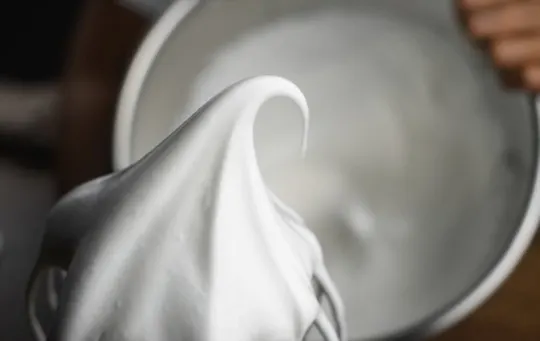
Soft Peaks are a crucial aspect of whipping cream or egg white for baking and cooking enthusiasts.
It refers to a texture of whipped ingredients that hold together softly without being too firm or stiff.
To achieve soft peaks, the mixture which could be either cream or egg white must be whipped carefully by using low to medium speed at the beginning and gradually increasing it until it achieves a foamy texture with gentle ripples that fall over when the whisk is lifted but still maintaining a semi-solid structure.
Achieving soft peaks is best for recipes requiring lighter textures, such as mousses, soufflé, and angel cakes.
When whipped to soft peak stage, it’s ideal for folding in other ingredients delicately without deflating the mixture’s air bubble entirely.
It’s important to note that whisking the mixture too far beyond the soft peak stage will result in stiff peaks or even worse if you go further it could turn into clumps.
Therefore, it is essential to know how much time and speed required to achieve this delicate stage.
Understanding the Differences Between Stiff Peaks and Soft Peaks
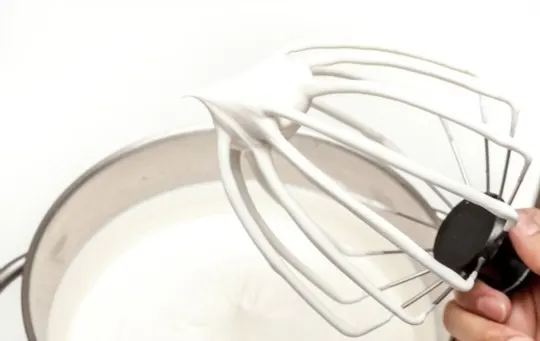
When it comes to whipping egg whites or heavy cream, there are two types of peaks to consider – stiff and soft.
These peaks differ in their texture, density, and stability.
While both peaks have their respective purposes, it’s essential to understand the differences between the two before choosing which one to use.
Stiff peaks have a denser consistency compared to soft peaks and hold their shape better when whipped.
They are formed by overbeating the mixture until it forms sharp, pointy tips that don’t bend when held upright.
Stiff peaks are generally used when you need structure in your finished product, such as angel food cake or meringues.
In contrast, soft peaks have a lighter consistency and form gentler slopes than stiff peaks.
They’re created by beating the mixture to a point where it holds its shape but still tips over at the top when lifted.
Soft Peaks are often used for recipes that require more lightness and airiness in their texture like creamy mousses or pies.
It’s important not to overbeat either type of peak as they can lose their structure and become dry or curdled.
A good way to check is if you can turn your bowl upside down without anything falling out.
Definition and Appearance
Achieving the ideal consistency for whipped cream or meringue can be challenging.
Two common peaks to consider are stiff and soft.
Stiff peaks hold their shape while soft peaks fold over.
The appearance of each will differ, with stiff peaks standing upright and retaining sharp edges, while soft peaks droop slightly and form a more rounded shape.
When making meringues, stiff peaks create more structure in the egg whites and provide greater stability during baking.
For whipped cream, the choice between soft or stiff peaks depends on its intended use.
Soft peaks work well for stabilizing sauces or adding volume to light desserts, whereas stiff peaks offer a sturdier structure for cakes or heavier dishes.
One factor to keep in mind is how long you intend to store your whipped creation.
Stiffer peaks tend to hold up better over time due to their greater resistance to gravity and environmental factors.
Ultimately, whether you opt for stiff or soft peaks comes down to personal preference, type of dish being prepared, and desired end result.
Usage in Baking and Cooking
Differentiating between stiff peaks and soft peaks is crucial in baking and cooking.
Stiff peaks are formed by whisking egg whites to create a firmer texture for meringues, soufflés, and other desserts.
Soft peaks are less firm and ideal for making whipped cream, mousses, and cakes.
Knowing when to use each type of peak is essential for achieving the desired results in your culinary creations.
When making meringues or soufflés, it’s important to achieve stiff peaks to ensure that the structure is maintained during baking.
Soft peaks are suitable for recipes that require a lighter texture, such as whipped cream or mousses.
Over-whisking can cause both types of peaks to become lumpy or dry, so it’s essential to pay close attention while whipping the ingredients.
It’s worth noting that not all recipes require egg whites to be whisked into either type of peak.
For instance, some cake batters may require a slightly aerated mixture rather than forming stiff or soft peaks separately.
In such cases, beating the eggs until they form ribbons ensures the desired level of aeration.
Hence it would help if you followed recipe guidelines carefully before deciding which peak type suits your dish.
Proper understanding of different peak types makes baking and cooking efficiently more quickly resulting in delicious outcomes every time.
Texture and Stability
When it comes to the texture and stability of whipped cream, two types of peaks can be achieved – stiff and soft.
Stiff peaks are achieved when the cream holds its shape firmly without slouching or falling over.
On the other hand, soft peaks are achieved when the peak is formed but falls over gently to form a curved tip.
Stiff peaks are preferred when the recipe requires a more solid and stable consistency, such as for frosting or decorating cakes.
Soft peaks, on the other hand, are best suited for light and airy recipes like mousse or chiffon cakes.
It’s important to note that achieving either type of peak is dependent on various factors like temperature, fat content, and bowl cleanliness.
However, once the desired peak consistency has been reached, it’s essential to stop whipping to avoid overbeating which can lead to grainy and oily whipped cream.
Applications in Different Recipes
Having stiff or soft peaks in a recipe can have different impacts on the final product.
Depending on the desired outcome, each option may be better suited for some recipes than others.
When making meringues or whipped cream, achieving stiff peaks is often preferable as it provides a fluffier texture and holds its shape well.
However, for delicate cakes or soufflés, soft peaks may be the better option as they allow for a more tender and light final product.
In addition to these common applications, there are other recipes where either option could work depending on personal preference or specific recipe requirements.
For example, when making macarons, some bakers prefer stiffer peaks to achieve a firmer cookie shell while others opt for softer peaks for a more chewy texture.
Similarly, when whipping egg whites for an omelette, using soft peaks instead of stiff can result in a creamier and more flavorful dish.
Understanding the differences between stiff and soft peaks is important when following recipes or experimenting with your own creations.
Being able to choose the right option based on the desired texture and consistency can make all the difference in achieving delicious results.
Comparing the Pros and Cons of Stiff Peaks and Soft Peaks
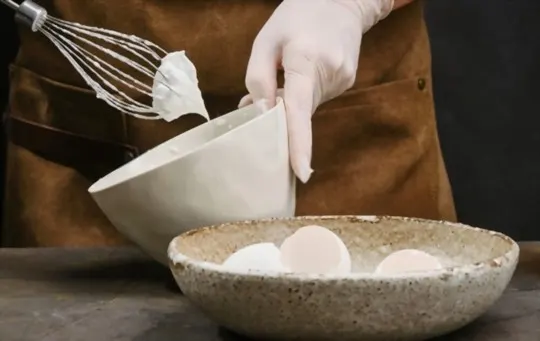
When it comes to whipping cream, there are two common options – stiff peaks and soft peaks.
Both have their pros and cons, and choosing the right one depends on the recipe you’re making.
Stiff peaks are achieved when the whipped cream stands up straight with sharp peaks that hold their shape.
This makes it perfect for decorating cakes and pastries as it holds its shape well.
However, stiff peaks can be difficult to fold into batters or fillings without deflating them.
On the other hand, soft peaks have gently rounded tops that droop slightly when lifted.
They are easier to incorporate into mixtures without losing too much air, making them great for incorporating into mousses and custards.
But they may not be ideal for decorative purposes as they do not hold their shape very well.
It’s ultimately up to personal preference and the needs of each recipe to determine which type of whipped cream is best.
Remember to carefully monitor your whipping time to achieve your desired peak consistency.
When to Use Stiff Peaks and When to Use Soft Peaks
When whipping egg whites or cream, it’s important to know when to use stiff peaks and soft peaks.
Stiff peaks are ideal for recipes that require structure and stability, such as meringues or soufflés.
Conversely, soft peaks work best for delicate desserts like whipped cream or angel food cake.
It all depends on the recipe’s desired texture and consistency.
However, it’s important not to overwhip either type of peak, as this can cause the mixture to become grainy and difficult to incorporate into other ingredients.
It’s also crucial to ensure that the bowl and beaters are completely clean and free of any grease, as even a small amount can prevent the egg whites or cream from forming peaks properly.
In addition to knowing when to use each type of peak, it’s also helpful to understand the visual differences between them.
Stiff peaks retain their shape when the beater is lifted out of the mixture and hold their form without collapsing.
Soft peaks hold their shape momentarily but then gently slump over without retaining their height.
By understanding these distinctions and tips for success, home bakers can confidently whip up professional-quality desserts every time.
Tips for Achieving the Desired Peaks
To achieve a balanced and perfect texture in peaks, few tips need to be kept in mind.
Proper knowledge and techniques can create either stiff or soft peaks as desired without making them overbeat or underwhelming.
- Use clean tools and bowls to beat egg whites or cream for good results.
- Add sugar gradually to prevent peaks from flattening out or being too sweet.
- Avoid adding cold ingredients to the mixture because it may not whip properly.
- If using an electric mixer, avoid overbeating, which can lead to breakage of foam structure.
- Keep an eye while mixing as its better to stop earlier rather than risking overbeaten peaks that will not hold their form.
Additionally, when preparing stiff peaks for meringue cookies, cream puffs, souffles or pavlovas where peaks hold their shape after baking, extra care should be taken with each step.
Mixing opposite directions in a circular motion helps gain volume quickly compared to beating back and forth horizontally.
Gradually incorporating salt stabilizes the egg whites and prepares firm meringues.
With these tips and tricks provided above, achieving this critical texture ratio in baked goods will surely become more feasible for you every time.
Conclusion
Achieving the perfect consistency of peaks is crucial in baking.
While there is no clear winner, understanding the differences between stiff peaks and soft peaks can help in choosing the right option for your recipe.
Stiff peaks hold their shape better, making them useful for meringues and whipped cream toppings.
On the other hand, soft peaks are more flexible and airy, suitable for mousses and chiffon cakes.
Ultimately, the choice depends on your desired texture and recipe requirements.
Experimenting with both techniques can help you determine what works best for you.
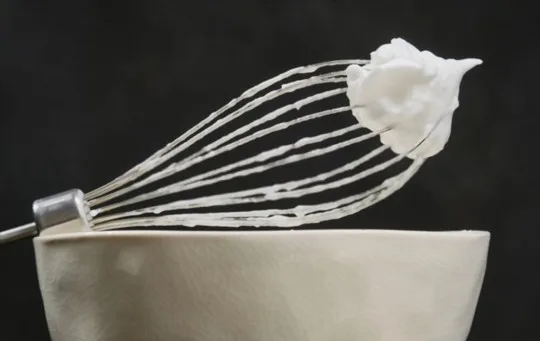
Stiff Peaks vs Soft Peaks: Which is a Better Option?
Ingredients
- Stiff Peaks
- Soft Peaks
Instructions
- Choose between two items based on your preference and availability.
- Follow the cooking directions for your chosen option, using the appropriate ratio of ingredients.
- Prepare it according to your desired recipes.
- Incorporate them into your dish, adjusting the amount to suit your taste.
- Enjoy the unique taste experience and experiment with different dishes to explore their versatility.

Andrew Gray is a seasoned food writer and blogger with a wealth of experience in the restaurant and catering industries. With a passion for all things delicious, Andrew has honed his culinary expertise through his work as a personal chef and caterer.
His love for food led him to venture into food writing, where he has contributed to various online publications, sharing his knowledge and insights on the culinary world. As the proud owner of AmericasRestaurant.com, Andrew covers a wide range of topics, including recipes, restaurant reviews, product recommendations, and culinary tips.
Through his website, he aims to inspire and educate fellow food enthusiasts, offering a comprehensive resource for all things food-related.

Leave a comment